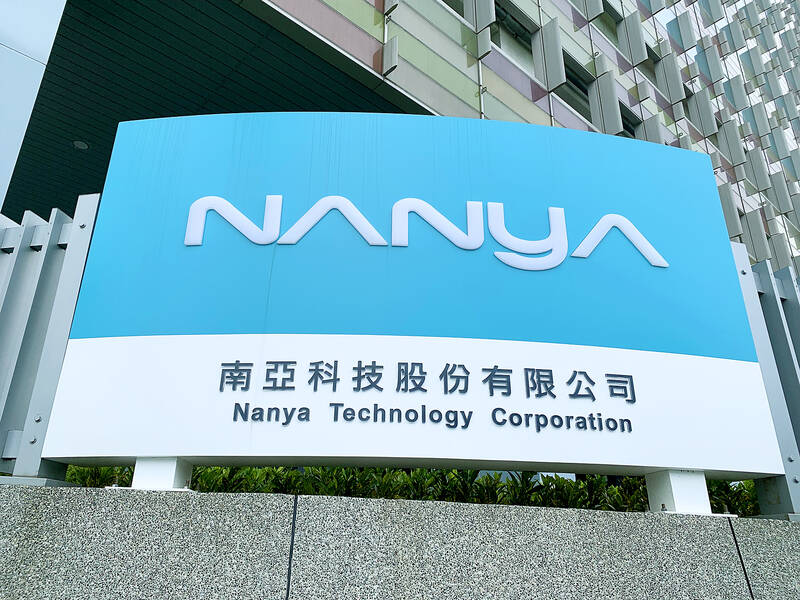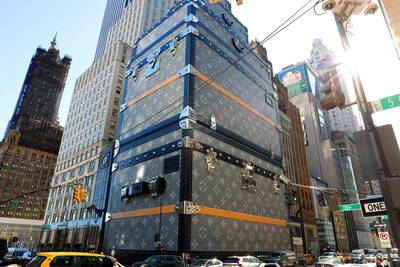DRAM chipmaker Nanya Technology Corp (南亞科技) yesterday said chip prices are expected to bottom out this quarter as supply chain inventory is diminishing at chip customers, paving the way for a gradual revival of DRAM demand in the second half of this year.
The improvement is most evident in the quarterly easing of an inventory glut in the mobile DRAM segment, which is aided by chip production cuts and a mild pickup in mobile phone demand due to China’s economic reopening, the memorychip maker told a media briefing in Taipei.
A recovery in China’s domestic demand and consumption is a key factor behind improved mobile phone sales, Nanya Technology president Lee Pei-ing (李培瑛) said.

Photo: Grace Hung, Taipei Times
However, the recovery would not happen overnight, but should come “step by step,” he said.
“As memorychip suppliers are adjusting capital expenditures and manufacturing capacity to cope with excessive inventory, we are seeing a mild improvement in [inventory] lately and expect significant [progress] in the second half,” Lee said.
In the first half of this year, DRAM demand remained dampened by surging inflation in the US and Europe, as well as Russia’s invasion of Ukraine, Lee said.
The technology dispute between the US and China also affects demand, he said.
For the whole of this year, global DRAM demand is expected to be lower than the average expansion of 10 to 20 percent annually in the past few years, but Nanya Technology is confident about the industry’s long-term growth outlook, Lee said.
To cope with the short-term downturn, Nanya Technology said it would this year slash capital spending by 10.62 percent to NT$18.5 billion (US$606.5 million) from NT$20.7 billion last year.
The the cuts would most severely affect spending on manufacturing equipment, it said.
However, it has no plan to cut jobs, Nanya Technology added.
The statement comes amid a wave of layoffs at US technology companies, including memorychip maker Micron Technology Inc, which this month announced a 10 percent reduction in its global workforce and salary cuts for senior executives.
Nanya Technology would continue to invest in research and development (R&D), as well as technology upgrades, Lee said.
The company’s R&D team comprises 1,000 people and it spent NT$7.8 billion on is efforts last year, or about 14 percent of its total revenue, Nanya Technology said.
The company said that it is making progress in developing next-generation DRAM technology and expects chips made on 10-nanometer nodes to contribute a single-digit percentage to its revenue by the end of this year.
With new technologies coming online, Nanya Technology said it is planning to add new products to its portfolio, such as new-generation DDR5 chips.
Nanya Technology said that the construction of its new Fab 5 would be complete as scheduled in 2025.
The company’s board of directors yesterday approved the distribution of a cash dividend of NT$2.13 per common share. That represents a 45.13 percent payout ratio based on the earnings of NT$4.72 per share last year.

STEEP DECLINE: Yesterday’s drop was the third-steepest in its history, the steepest being Monday’s drop in the wake of the tariff announcement on Wednesday last week Taiwanese stocks continued their heavy sell-off yesterday, as concerns over US tariffs and unwinding of leveraged bets weighed on the market. The benchmark TAIEX plunged 1,068.19 points, or 5.79 percent, to 17,391.76, notching the biggest drop among Asian peers as it hit a 15-month low. The decline came even after the government on late Tuesday authorized the NT$500 billion (US$15.2 billion) National Stabilization Fund (國安基金) to step in to buoy the market amid investors’ worries over tariffs imposed by US President Donald Trump. Yesterday’s decline was the third-steepest in its history, trailing only the declines of 2,065.87 points on Monday and

TAKING STOCK: A Taiwanese cookware firm in Vietnam urged customers to assess inventory or place orders early so shipments can reach the US while tariffs are paused Taiwanese businesses in Vietnam are exploring alternatives after the White House imposed a 46 percent import duty on Vietnamese goods, following US President Donald Trump’s announcement of “reciprocal” tariffs on the US’ trading partners. Lo Shih-liang (羅世良), chairman of Brico Industry Co (裕茂工業), a Taiwanese company that manufactures cast iron cookware and stove components in Vietnam, said that more than 40 percent of his business was tied to the US market, describing the constant US policy shifts as an emotional roller coaster. “I work during the day and stay up all night watching the news. I’ve been following US news until 3am

Six years ago, LVMH’s billionaire CEO Bernard Arnault and US President Donald Trump cut the blue ribbon on a factory in rural Texas that would make designer handbags for Louis Vuitton, one of the world’s best-known luxury brands. However, since the high-profile opening, the factory has faced a host of problems limiting production, 11 former Louis Vuitton employees said. The site has consistently ranked among the worst-performing for Louis Vuitton globally, “significantly” underperforming other facilities, said three former Louis Vuitton workers and a senior industry source, who cited internal rankings shared with staff. The plant’s problems — which have not

TARIFF CONCERNS: The chipmaker cited global uncertainty from US tariffs and a weakening economic outlook, but said its Singapore expansion remains on track Vanguard International Semiconductor Corp (世界先進), a foundry service provider specializing in producing power management and display driver chips, yesterday withdrew its full-year revenue projection of moderate growth for this year, as escalating US tariff tensions raised uncertainty and concern about a potential economic recession. The Hsinchu-based chipmaker in February said revenues this year would grow mildly from last year based on improving supply chain inventory levels and market demand. At the time, it also anticipated gradual quarter revenue growth. However, the US’ sweeping tariff policy has upended the industry’s supply chains and weakened economic prospects for the world economy, it said. “Now